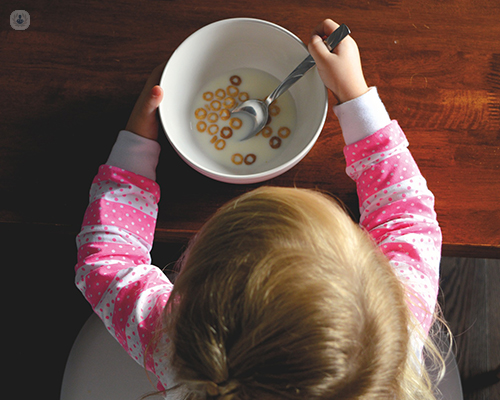Don’t take the risk: know your child’s food allergies
Escrito por:Allergic reactions can be scary, especially if the root cause of them is unknown. A common cause is food, but there are many kinds of foods and that can make finding the root cause difficult. To explain the process of discovering where the allergy comes from and how it is handled, leading paediatric allergist Dr Helen Brough has provided thorough answers to important questions in this article.

How can I tell if my child has a food allergy? What are the common symptoms?
If your child has a food allergy, they can either have two different types of allergies: an immediate food allergy or a delayed food allergy. The immediate food allergies are the ones that people recognize mostly because they occur immediately after eating the food or within one to two hours. Classically, the symptoms will be:
- Hives like a nettle rash, some swelling around the mouth or the eyes; it can extend to different parts of the body
- Vomiting or having loose stools
- Sneezing or rubbing the nose and/or eyes
- Rarely - anaphylaxis (problems breathing)
- Persistent cough or swollen tongue, difficulty breathing, or wheezing
- An impact on blood pressure, becoming dizzy or suddenly sleepy, pale, or floppy
This is all mediated by a few different parts of the immune system, but mainly IgE (immunoglobulin E antibodies made by the immune system).
In a delayed food allergy, children don't have immediate responses to the food but will have more delayed responses, which can be a wide range of symptoms. They are not mediated by IgE but are mediated by a different part of the immune system. This can lead to:
- Itching
- Flare up of redness on the skin
- Dry itchy patches like eczema
- Little dots under the skin
- Gut issues - in young babies particularly severe colic, loose stools, constipation, or gastroesophageal reflux
A classic example in babies is cow's milk proctocolitis, where the child can have bloody stools in the first few weeks of life through exposure to cow's milk.
What food allergies are commonly found in children?
In the UK and in many other western countries, the range of food allergy in children is between 6 to 8 per cent. There was a recent study which showed that it was 7.1 per cent in the UK; 2 to 3 per cent for immediate food allergies, but likely more than that for delayed allergies.
Of those the common food allergies, egg is first at around 5 per cent of children. There's a wide range for cow's milk because house milk causes immediate food allergies, but more commonly delayed food allergies. Peanut allergy is also quite prevalent in children at around 2 to 2.5 per cent. There are other food allergies like tree nut allergy, sesame seed allergy, fish allergy, wheat allergy, soya allergy, and kiwi allergy. Then there are rarer food allergies that we're starting to see like chia seed allergies and other foods that are being introduced into the diet.
At what age do food allergies normally develop in children? Can they come on suddenly?
Children are not born with food allergy or eczema; they are developed as they get older. There is, however, a narrow window of opportunity to prevent food allergy for children that do develop eczema, because most food allergy develops by 1 year of age.
Food allergy often is present the first time the child eats the food. For example, with peanut and egg, very often the first time the child has an allergic reaction is the first time the child has eaten a scrambled egg or has had a little bit of peanut butter on toast; people wonder why that has happened because they think, well, they surely must have eaten it once before for the body to realise that they're going to become allergic to it. However, what we now realised is that people can become allergic through the skin. By having eczema which is red and inflamed and angry on their skin, if they're exposed to these foods in the environment onto their skin then they can have an increased risk of developing allergy to those foods. So yes, they can come on apparently suddenly, but that's because they were already allergic, they just hadn't had that food yet.

How are food allergies in children diagnosed?
In children that have a history of immediate food allergies, we have a range of accurate tests that we can now do to predict whether this child has a food allergy. We also have access to some research tests which can predict the severity and threshold level of the food reaction. The ones that we commonly do when seeing a patient in clinic is done by taking an allergy focused history and then doing skin prick testing; we have specialist commercial extracts to the different foods, but parents can also bring some fresh fruits and vegetables if they're wondering about those. We can do skin prick testing to all those, as well as environmental allergens like grass pollen which we do as a part of our practice.
As mentioned, immediate food allergy is driven by the antibody IgE, and we now have access to very sophisticated blood tests which look at the parts of the protein within the food so that you can see if the child is allergic to those parts of the protein. It’s very helpful to differentiate between primary food allergy (the ones that can cause severe allergic reactions) or pollen food syndrome which is because of hay fever and usually leads to mild reactions.
For delayed food allergies it is more difficult to make a diagnosis. We offer patch testing to food, but the most accurate way to assess whether the child is allergic to that food or not is by doing a careful exclusion of that food with dietary input to ensure that there is no nutritional harm from that, followed by reintroduction whilst keeping a diary of symptoms.
What advice do you give to parents when their child is diagnosed with having allergy?
When a child is diagnosed with having an allergy, it's important that the allergy is confirmed with proper allergy testing. I have seen quite a few patients where they thought that they'd reacted to one food where they had reacted to something else. For example, a family came to see me because they thought their child had an egg allergy, but it turned out that the scrambled egg had been prepared with cow's milk and the child was actually allergic to the milk, not the egg. So, it's important to get proper allergy testing to see what the child is allergic to; sometimes it's not actually a food allergy. That's the first thing to get a proper diagnosis.
Once you have a proper diagnosis, then you need to be given advice on how to avoid that food, the precautions you need to take, such as:
- Allergen avoidance e.g reading allergy labels on packaged foods
- How to deal with 'may contain' labels
- How to deal with going out to restaurants
- How to deal with foods from takeaways
- How to recognize when your child is having an allergic reaction
- Knowing what to do with each type of symptom
- Having an emergency plan to know how to manage your food allergy
- Having suitable alternatives to the food to ensure your child's nutrition and growth is not compromised
I always provide my patients with a personalized emergency treatment plan for their food allergy. For mild to moderate symptoms like having a rash or swelling of the eyes or lips, vomiting, a change in behavior, they are managed with an antihistamine. For a more severe allergic reaction (anaphylaxis) which could affect their airway, their breathing, or their consciousness, the gold standard treatment is intrasmuscular adrenaline. First parents need to ensure their child is in the right position. If they're having problems with consciousness, they need to lie down with their legs raised. If they're having problems with their airway or with their breathing, they can sit up, but they should not be upright. They should use the adrenaline auto injector immediately (we always provide training on how to use this in my clinic), and then they need to stay in the same position, not get up, and somebody needs to call 999 and say the words 'anaphylaxis'.
I provide prescriptions to my patients for the emergency treatments that they require which can be issued privately or they can ask their GP to prescribe. I always give them written information on how to manage their allergies and written information about the type of food that we have confirmed an allergy to. I also have dietitians that work closely with my practice, for more advice on how to avoid the food, how to supplement any nutrients lacking in the diet, and recipes for alternative foods.
If your child is experiencing food allergies or you would like more information, you can schedule a consultation on Dr Brough’s profile.


